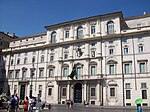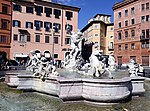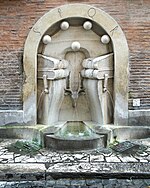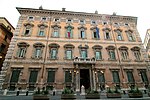Fontana dei Quattro Fiumi

Fontana dei Quattro Fiumi (Fountain of the Four Rivers) is a fountain in the Piazza Navona in Rome, Italy. It was designed in 1651 by Gian Lorenzo Bernini for Pope Innocent X whose family palace, the Palazzo Pamphili, faced onto the piazza as did the church of Sant'Agnese in Agone of which Innocent was the sponsor. The base of the fountain is a basin from the centre of which travertine rocks rise to support four river gods and above them, a copy of an Egyptian obelisk surmounted with the Pamphili family emblem of a dove with an olive twig. Collectively, they represent four major rivers of the four continents through which papal authority had spread: the Nile representing Africa, the Danube representing Europe, the Ganges representing Asia, and the Río de la Plata representing the Americas.
Excerpt from the Wikipedia article Fontana dei Quattro Fiumi (License: CC BY-SA 3.0, Authors, Images).Fontana dei Quattro Fiumi
Piazza Navona, Rome Municipio Roma I
Geographical coordinates (GPS) Address Nearby Places Show on map
Geographical coordinates (GPS)
| Latitude | Longitude |
|---|---|
| N 41.898888888889 ° | E 12.473055555556 ° |
Address
Piazza Navona
Piazza Navona
00186 Rome, Municipio Roma I
Lazio, Italy
Open on Google Maps










